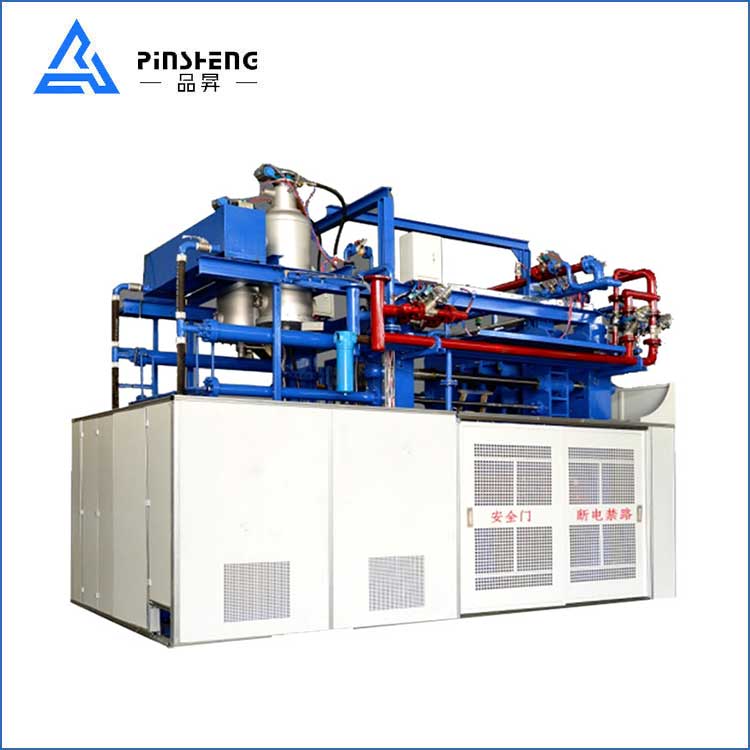- English
- Español
- Português
- русский
- Français
- 日本語
- Deutsch
- tiếng Việt
- Italiano
- Nederlands
- ภาษาไทย
- Polski
- 한국어
- Svenska
- magyar
- Malay
- বাংলা ভাষার
- Dansk
- Suomi
- हिन्दी
- Pilipino
- Türkçe
- Gaeilge
- العربية
- Indonesia
- Norsk
- تمل
- český
- ελληνικά
- український
- Javanese
- فارسی
- தமிழ்
- తెలుగు
- नेपाली
- Burmese
- български
- ລາວ
- Latine
- Қазақша
- Euskal
- Azərbaycan
- Slovenský jazyk
- Македонски
- Lietuvos
- Eesti Keel
- Română
- Slovenski
- मराठी
- Srpski језик
What Are the Key Points to Note in the Operation Process of Epp Machine?
2025-06-20
EPP Machine (foamed polypropylene molding machine) is a core equipment specially used to process polypropylene beads (EPP raw materials) into various complex-shaped foam products. Its main function is to fill the pre-foamed EPP beads into a specific mold cavity. Under the combined effect of thermal expansion and steam pressure, the beads further expand and fuse to form, and finally form a three-dimensional component with excellent cushioning, heat insulation, light weight, chemical resistance and environmentally friendly recyclable properties.

Brief description of the operation process:
Raw material preparation and filling: The pre-foamed (completed in the pre-foaming machine) and matured and stabilized EPP beads are accurately and evenly injected into the closed molding mold cavity through a filling gun or an automatic feeding system. The filling amount needs to be precisely controlled to ensure the product density and size.
Mold preheating (optional): In order to shorten the molding cycle and improve efficiency, the mold is usually preheated to a certain temperature (such as 40-60℃).
Steam heating molding (core stage):
Steam penetration: High-temperature steam (usually above 130°C) is introduced into the mold. Steam penetrates the entire bead filling area through the exhaust holes on the mold or specially designed channels.
Secondary expansion and sintering: High-temperature steam activates the residual foaming agent inside the beads and softens the surface of the beads. After absorbing heat, the beads undergo secondary expansion, and are squeezed and deformed by high-pressure steam. The softened layers on their surfaces contact each other, melt, and finally bond and solidify to form an integrated closed-cell foam.
Pressure and time control: Steam pressure (usually 0.1-0.4 MPa) and penetration and holding time must be set strictly according to product size, thickness, and density requirements to ensure that the beads are fully fused and shaped, and there are no poor sintering or non-penetrated areas inside.
Cooling and shaping: After the molding stage is completed, close the steam inlet valve and introduce cooling water to force cool the mold and the internal product (or use water ring vacuum to assist cooling). This step solidifies the sintered beads to prevent deformation after demolding. Cooling must be sufficient and uniform.
Demolding and taking out: After cooling is completed, open the mold and use the ejection mechanism (ejector, air blowing, etc.) to eject the molded and solidified EPP product from the mold cavity. At this time, the product temperature is still high and needs to be carefully removed to prevent deformation.
Post-processing (optional): Newly demolded products may contain a small amount of moisture and usually need to be dried (natural drying or drying). Some products may require post-processing steps such as trimming flash.
Mold preparation: Clean the mold cavity of the EPP Machine and perform necessary inspections to prepare for the next molding cycle.
There are several key points to pay attention to:
Steam quality: Dry, stable, and pressure-controlled steam is essential.
Mold design: The exhaust channel design of the mold directly affects the steam penetration efficiency and the uniformity of the product density.
Process parameters: Steam pressure/temperature, time of each stage (heating, holding pressure, cooling), and vacuum degree (if applicable) are core process parameters and need to be precisely controlled.
Safety and maintenance: The operation involves high-temperature and high-pressure steam, and safety regulations must be strictly followed; regular maintenance of equipment (seals, valves, control systems, etc.) ensures stable operation.
EPP Machine precisely controls steam heat energy and pressure to allow pre-foamed EPP beads to expand again in the mold and fuse into lightweight, high-strength foam products of the desired shape, which are widely used in the automotive, packaging, logistics, consumer goods and other fields.

